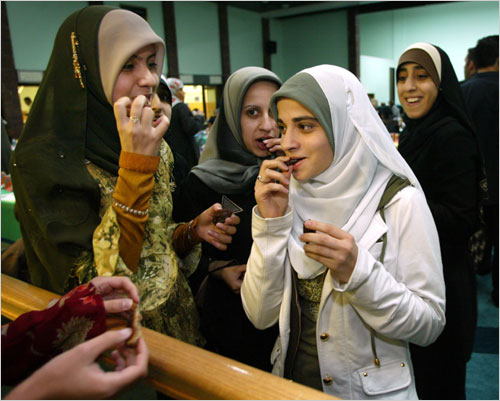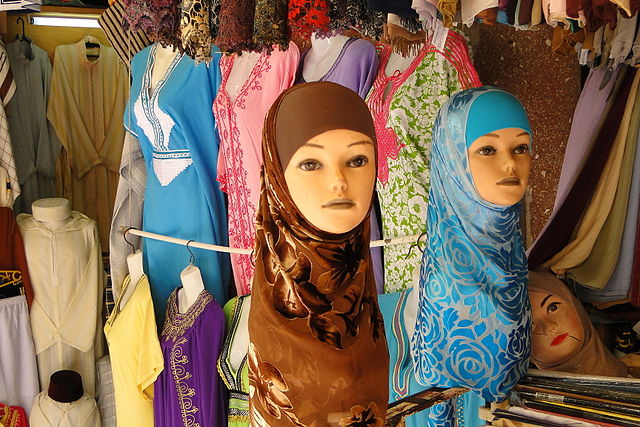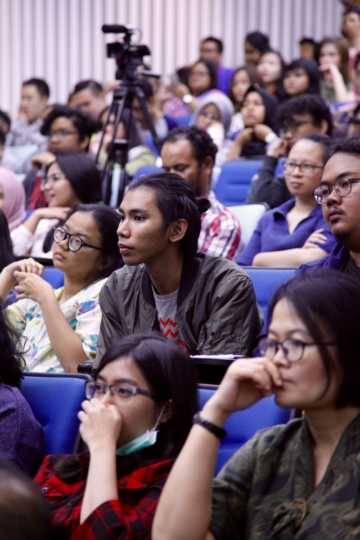Global Plus—Baring souls: How modest fashion is upending anti-Islamic bias and empowering woman of all faiths

EDITOR’S NOTE: This column was reposted to the IARJ website with permission from the ARDA’s Global Plus by the IARJ’s David Crumm.
Sara,
a senior attorney in the British civil service, strives to meet the highest fashion standards with stylish clothing befitting her Muslim faith from houses such as Escada, Max Mara and Dior.
Resonant of fashion icons such as Audrey Hepburn, Coco Chanel and Jackie Onassis, the self-confessed fashionista covers her head with expensive designer scarves. I try and make sure that they see me as professional first, (that they) see me,
she says.
What she refuses to do is change her style because many of the men at her work cannot understand that a Muslim woman can have a voice, be articulate and challenge them. (It’s) too much for them to understand that you have a brain because society (presumes) that these women are trapped and coerced and we need to liberate them. (But) no one needs to liberate me, and (certainly) not them
Perhaps no image has come to define Islamic women as much as the head covering, known in many contexts as a hijab.
Secular governments fear it, so much so in places like France they try to legislate it out of the public eye. The media often portray the hijab as a symbol of subservience associated with a backward and violent faith. Women who wear it face censure and surveillance from those both within and outside their faith.
So why is the head scarf at the forefront of a modest fashion movement
that is upending stereotypes and empowering women of all faiths?
It is because of women like Sara and countless others across the globe who have built a movement that has demanded and claimed space for women to be fashionable and faithful to their beliefs.
Fashion is often viewed as frivolous. And the industry itself can be autocratic, setting unrealistic standards of beauty that can shame and damage the body image of women from their teens onward: If you’re fat, you can’t buy clothes; if you’re older, you can’t buy clothes. It has taken decades of fat activism to get the fashion industry to wake up to the needs of – and the business case for catering to – the plus size
or curve
market.
Muslim modest dressers, and those in other religious communities, are making similar inroads. The new modest fashion shows another side of the industry, the ability of a major social and economic engine to influence cultural change.
How much change?
Consider that what began as a loose collection of designers, bloggers and young women envisioning and creating stylish clothing that is consistent with their beliefs has grown to the point where one can now see women in Muslim modest dress on commercials for products from Pepsi to Nike.
Global retail behemoths such as Walmart and DKNY are offering Ramadan collections. The market for modest Muslim Islamic fashion alone is expected to grow from $243 billion in 2015 to $368 billion in 2021.
Slowly, the stereotype of the hijab as a potent political symbol of the outsider status of Muslims is eroding.
Today, stylish women of many faiths that encourage modesty have embraced coverings or other relevant adaptions of dress and behavior as signs of fashion and faith.
In so doing, this largely women-led movement is breaking down legal and social barriers to religious freedom.
Movement luminaries also are engaging the world’s leading religions with the rights of women to interpret religious texts and religious practices in everyday life in ways informed by their own conscience and authority.
Sound at all familiar?
In more than 10 years of studying the modest fashion movement, I often find myself thinking of its quest for social inclusion as a coming out story similar to the journey toward public and personal acceptance experienced by lesbian/gay/bisexual/queer/trans communities.
For all the governments that try to legislate what women wear, for all the men who still think it is their right to have women reveal – or cover – themselves for their judgment, for all the extreme conservatives and liberals, both religious and secular, who think they have a right to tell women how to dress, here are four words of caution:
Get used to it.

Birth of a movement
People from the majority culture often cannot imagine how hateful and alienating it can be to be disregarded by consumer culture and vilified in popular culture.
Consider what it has been like for young Muslim women in the West in the first part of the new millennium.
Centuries of Orientalist stereotypes came roaring back after the 9/11 terrorist attacks in New York City in 2001. There were pictures of veiled women all over the press, often illustrating stories that were not even about women but were about this presumed distance between modernity understood as Western and the Middle East understood as non-modern – the clash of civilization thesis.
In the UK, anti-Muslim prejudice and stereotyping rose again in July 2005 following the attacks on the London transit system. Some Islamic leaders cautioned Muslim women about wearing hijabs or other clothing that might make them targets.
Yet, one month later, walking from Oxford Circus to Marble Arch, what I encountered were several scenes of highly visible Muslim
women. They included:
- Girls with patterned scarves over their hair clustered around the makeup counter in Top Shop.
- Hip 20somethings in black boot-cut trousers and skimpy T-shirts wearing their head wraps tight with a ghetto-fabulous tail flowing down their backs.
- Clusters of young women wearing long loose-fitting garments known as jilbabs looking at handbags in Selfridges.
It was a different response than was common in the global Islamic revival in the 1970s. Then, many Muslim women chose to separate themselves from what they considered Western colonial oppression and consumerism by adopting simple forms of dress, often dressing in black with inexpensive fabrics in garments sewn at home.
What had changed this time was that many young Muslim women were now raised in third- and fourth-generation families in the West. They grew up in a consumer culture, and fashion was a part of their lives.
This did not mean denying their spiritual identity. In 2005, a British poll found four-fifths of young Muslims opposed a school’s right to ban the hijab, up from 57 percent just a year before. Five in six young Muslims challenged the right to ban such head coverings in the workplace.
It is not just for their own pleasure in fashion and style that many of these women are developing new covered fashion that deploy the colors, shapes and styles of the global fashion industry.
These hijabis hope that by looking like other women on the high street, they will move away from stigmatization and toward social inclusion.
They are determined to be both Muslim and fashionable.
Muslim designers and bloggers have responded to a market that had been ignored by the fashion industry. New fashion magazines such as Azizah (Countering stereotypes and misconceptions with every issue
), emel and Muslim Girl also raised awareness.
As the word got around through blogs and social media in the modest fashion world, they found allies in other faiths and among people with no religious affiliation. In Jewish communities, modern Orthodox women were wearing head coverings and dressing modestly in greater numbers. Christian women also were seeking fashionable designs that were consistent with the sense of modesty that was part of their beliefs.
Today, it is an interfaith market, with scores of popular magazines and thousands of bloggers targeting audiences from Orthodox Jewish women to members of the Church of Jesus Christ of Latter-day Saints.
And it is attracting the attention of the fashion industry.
In 2015, the video went viral when H&M selected Mariah Idrissi to become the first hijab-wearing model to be featured in one of its campaigns. The fashion chain Mango promoted Ramadan collections and designers such as Oscar de la Renta and Tommy Hilfiger are testing the market. Dolce & Gabbana launched a collection of abayas, or loose robes, and hijabs.
Yet the old concerns have not gone away.
U.S. President Donald Trump and a host of secular and right-wing political leaders in Europe continue to fan anti-Muslim bias. The hijab, in particular, continues to be vilified as a path to extremism and a threat to national identity.
But Muslim women and others in the modest fashion movement are not stepping away from the challenges of promoting social inclusion in societies that only want assimilation on their terms.
They are leaning in.

A common path
Where we can go so terribly wrong in society is making blanket judgments about an entire group of people.
Each of us in our own groups, among the tens of thousands of movements within Christianity, the variety of understandings of what it means to be Jewish, the multiple ways secular individuals find meaning, almost take it for granted that we should be judged as individuals.
Yet what should be obvious, that Muslims, too, like everyone else live lives that can be filled with chaos and contradiction. Like everyone, Muslims have multiple ways of interpreting their faith – yet this is so frequently lost among narratives of fear, ignorance and bias.
Stereotyping renders Muslims as good or evil depending on if and how they conform to prevailing majority norms. The hijab becomes a controversial political symbol. And Muslim women continue to be saddled with centuries-old images of being the powerless women behind the veil.
But the social reality of lived religion is that it can be messy and complicated.
There is no one reason Muslim women wear the hijab.
Some choose the hijab because it easier to avoid tensions within their family and community. Some wear it as an expression of faith. Some wear it as an expression of fashion and style that makes them feel comfortable. Some wear the hijab for a while and find it is not right for them. And some wear it precisely to destigmatize what has become stigmatized through anti-Muslim prejudice.
And many wear it for a combination of some or all of those reasons. What is becoming clear is that more young women seem to be covering their hair, and that some older women who felt pressured to relinquish practices that marked them out as Muslim are becoming emboldened to wear the hijab again.
A number of young women would tell me, Oh my mum has started to cover quite properly now.
So it transmits up well.
For many young Muslims, facing rising Islamophobia and constant press coverage linking Islam with terrorism, being visibly Muslim and visibly fashionable is a way to promote positive understandings of their community. For some, the act in itself is considered a form of da’wa, or an act of teaching others about their faith.
What is also important throughout the movement is to maintain respect for different interpretations, including for those Muslim women who do not interpret head coverings as necessary to their faith. Or those who become dejabis,
finding it did not work for them for reasons ranging from social pressure to changing religious interpretations, or entering new life phases.
Most women in the movement would say, This is what I think is appropriate, I respect if some think it is right to dress in a different way, but I wouldn’t do that.
In other words, no one should be forced to wear or forced not to wear the hijab. If the movement had a mantra, it would be, Unless it is freely chosen, it is not authentic.

An uncertain future
No one is saying shopping will lead to world peace.
But the path to greater religious and personal freedoms paved by the modest fashion movement should not be underestimated.
We know from a growing body of research that denying religious freedoms and provoking hostility toward minorities ignites a downward cycle of persecution and violence, heightening tensions and increasing grievances that can feed conflict. One global study found that social restrictions on religion, even more than government restrictions, held the most direct and powerful relationship with conflict and violence.
What people in the modest fashion movement are doing in part is carving out space in Western culture for Muslim women. They are taking away the power of others to define the hijab, and gaining popular ground by defining their mode of dress as a statement of fashion and faith and an affirmation of free choice.
Nor should it be overlooked that they are reducing potential tensions by creating greater economic opportunities for Muslim women as employers become more accepting of hiring women with head coverings.
And their influence does not stop there.
Many in the movement take issues of fashion and religion very seriously; they are taking ownership in developing new theological understandings of how their faith relates to how they dress.
For all the doctrinaire determination emitting from babble from far-left and far-right groups about the dictates of religious fashion, Scripture in many faiths leaves plenty of room for interpretation beyond advocating modesty.
What I encountered in my work were all these smart young women developing new forms of religious practice, new forms of religious knowledge as they engaged with these issues.
In convening the Second Vatican Council in the 1960s, the Catholic Church was said to be opening its windows to the modern world.
One might also say the modest fashion movement is opening a window to a new social reality where women take a leading role in interpreting religious practices and texts.
Why can’t we think of these women as creating paths to new forms of religious knowledge and demonstrating new styles of influence, inspiration, and leadership?
What we do not know is the future of modest fashion.
Hot fashion trends inevitably cool off. New generations of women will have their own ideas.
There may come a day in the not so distant future when fashionable modest dress, among Muslim women in particular, is no longer considered exceptional. Modest dress may just become one more routine offering on store shelves.
What I do not expect is that modest fashion will shrink back out of sight in the marketplace.
The new alliances and aesthetics being developed, along with the openness to multiple modes of expression in hijabi and other forms of modest fashion, are becoming embedded in commerce, commentary and daily religious practice throughout the world.
My hope is that the movement will prove beneficial not just for those who wear the clothes, but for those who live with and around them.
Reina Lewis is Artscom Centenary Professor of Cultural Studies at London College of Fashion, University of the Arts London. She is a leading researcher and writer on fashion and faith.
Image by Luluty hijab, via Wikimedia Commons [CC BY-SA 4.0]
Image by U.S. Department of State, via Wikimedia Commons [Public Domain]
Image by Adam Jones, Ph.D., via Wikimedia Commons [CC BY-SA 3.0]
Image courtesy Universitas Multimedia Nusuntara
Resources
- ARDA National Profiles: View religious, demographic, and socio-economic information for all nations with populations of more than 2 million. Special tabs for each country also allow users to measure religious freedom in the selected nation.
- ARDA Compare Nations: Compare detailed measures on religion on any nation, including religious freedom and social attitudes, with similar measures for up to seven other nations.
- Islamic Fashion & Design Council. The council publishes Cover magazine, and offers research, commentaries and listings of events related to the global modest fashion market.
- Modest fashion blogs: Some popular modest fashion blogs representing different belief systems can be found here. Some popular Muslim fashion blogs include these.
- Muslim Fashion and Global Politics. Listen as Reina Lewis discusses the larger implications of the rise of modest fashion.
Articles
- Almassi, Hannah, What Does Modest Fashion Really Look Like? An overview of the global modest fashion market.
- Palmer, Nathaniel. The Muslim Fashion Market Is Not a Monolith. The article explores the diversity of the consumer market for Muslim fashion.
- Gander, Kashmira. Modest Fashion: How Covering Up Became Mainstream. The article examines how mainstream brands have found themselves playing catch-up to appeal to women who dress modestly for religious and cultural reasons, including Muslims, Jews and Christians.
Books
- Ahmed, Lelia. A Quiet Revolution: The Veil’s Resurgence, from the Middle East to America. The book explores the veil’s resurgence, from Egypt through Saudi Arabia and into the West, suggesting a dramatically new portrait of contemporary Islam.
- Lewis, Reina. Modest Fashion: Styling Bodies, Mediating Faith. The book sheds light on the growing number of women who, for reasons of religion, faith or personal preference, decide to cover their bodies and dress in a way that satisfies their spiritual and stylistic requirements.
- Lewis, Reina. Muslim Fashion: Contemporary Style Cultures. This insightful and nuanced work based on more than a decade of research offers compelling insights into how the world of modest fashion is enabling Muslim women and women from other faiths to negotiate issues of religion, identity and ethnicity.
- Eds. Moors, Annelies, and Tarlo, Emma. Islamic Fashion and Anti-Fashion: New Perspectives from Europe and North America. Introducing innovative research from international scholars working on Muslim fashion and its critics, the book provides a global perspective on Muslim dress practices
